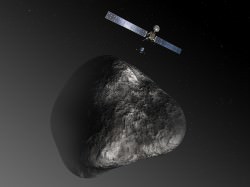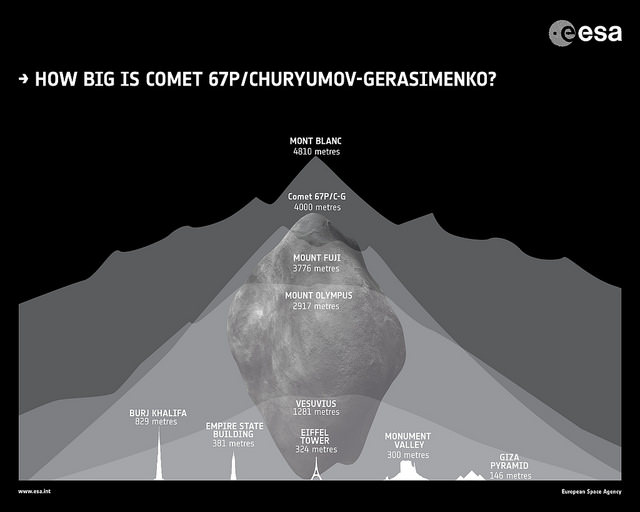Pretty darn big, I’d say.
The illustration above shows the relative scale of the comet that ESA’s Rosetta and Philae spacecraft will explore “up-close and personal” later this year. And while it’s one thing to say that the nucleus of Comet 67P/Churyumov-Gerasimenko is about three by five kilometers in diameter, it’s quite another to see it in context with more familiar objects. Think about it — a comet as tall as Mt Fuji!

At the time of this writing Rosetta is 35 days out on approach to Comet 67P/C-G, at a distance of about 51,000 km (31,700 miles) and closing. Three “big burn” maneuvers have already been performed between May 7 and June 4 to adjust the spacecraft’s course toward the incoming comet, and after smaller ones on June 18 and July 2 there are a total of five more to go. See details of Rosetta’s burn maneuvers here.
As incredibly sensitive as they are, Rosetta’s instruments — which were able to detect the water vapor coming from Comet 67P/C-G from a distance of over 360,000 km — have even sniffed the hydrazine exhaust from its own thruster burns.
Luckily the remaining burns are relatively small compared to the first three, with the final being very brief, so any data contamination by Rosetta’s own exhaust shouldn’t become an issue once the spacecraft has established orbit in August.
Read more: Rosetta’s Comet Already Sweating the Small Stuff
Launched in March 2004, ESA’s Rosetta mission will be the first to orbit and land a probe on a comet, observing its composition and behavior as it makes its close approach to the Sun in 2015. Click here to see where Rosetta is right now.
Source: ESA’s Rosetta blog
Note: While 3-5 km seems pretty big (especially when stood on end) comet nuclei can be much larger, 10 to 20 km in diameter up to the enormous 40+ km size of Hale-Bopp. As comets go, 67P/C-G is fairly average. (Except that, come August, it will be the only comet with an Earthly spacecraft in tow!)

